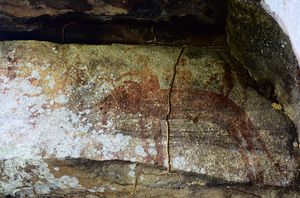Veal Veng was once just one village in a chain that stretched south from Phnom Kravanh town deep into Cambodia’s Cardamom mountains.
Now the village, a jumble of wooden and bamboo huts, is the only one remaining and serves as the gateway to a collection of rock paintings believed to be drawn as early as 2,500 years ago.
Getting to the site in Pursat province, described by experts in a paper released last year as a unique site deserving “special attention,” is no easy feat.
Traditionally reached along a single track by buffalo-drawn cart — which is still the only method of travel during the height of the rainy season — the 25-km journey between Phnom Kravanh and Veal Veng is mostly now done by motorbike. The recent damming of the small Stung Pram river to form a large reservoir, which according to local authorities is to aid farmers during the dry season, led not only to the destruction of a number of houses and farms, but has added a 30-minute ferry ride to the journey.
Driving slowly along the deeply rutted tracks, the only other travelers were loggers, brazenly harvesting the remaining valuable timber before it is destroyed by the reservoir. That, at least, is the excuse Veal Veng village chief Khvek Dim said the loggers are using. He laments the loss of trees and wildlife from his simple hut in the center of the village.
Mr. Dim has known about the paintings on the sheltered rock-face about 20 minutes south of the village, along the track that used to lead to the even remoter villages, for as long as he can remember. As a child he would sit by the paintings to shelter from the rain, tracing his finger over the depictions of elephants, deer and other unidentified animals.
He has no idea how old the paintings are, nor does anyone in the village, but the site has long been a site of religious significance, and plays host to annual festivities marking Pchum Ben, when Cambodians pay respects to their ancestors.
As to who painted them, local lore states they are the work of a mysterious group of people, who wanted to document the once common animals in the region for future generation to enjoy, but who fled after being repeatedly disturbed by the children from the village.
The village’s children have proven to be a persistent menace to the site, with smoke damage to the rocks blamed on fires lit in the past 20 years. At some point, children have also been inculpated for the appearance of chalk marks outlining some of the artwork.
In 1974, Mr. Dim recalls Khmer Rouge soldiers fighting with villagers for control of the region. He was a trainee monk at the time, and sadly recalls the loss of a silver elephant statue that had been in village for generations, and the destruction of the two large stupa next to the rock site to build a now abandoned dam.
After taking six hours to get to the site, which involved carrying motorbikes across three streams swollen with the first rains of the rainy season, offers to spend the night in the village were politely declined. With friendly wave from Mr. Dim and the sizable delegation from the 30 or so village families, the return journey took four hours — aided in no small part by the menacing grey clouds building overhead.
For now, the paintings remain safe. As the journey to reach the site proved, it is unlikely to rival Angkor Wat as a tourism destination any time soon. Instead, without preservation efforts from the government, “spalling, insect nests and trails, plant growth, lichens, moss, salt, wind and water erosion, various natural chemical processes [and] fading” remain the biggest threats, so long as the pesky kids don’t continue their contributions to the artwork.
Peter Ford is a freelance journalist based in Phnom Penh, Cambodia.















































